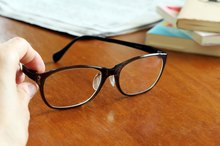Problems With Multifocal Contact Lenses
Wearing multifocal contact lenses gives individuals the ability to focus through different strength prescriptions, but through the same lens. The technology uses a single lens for each eye rather than multiple lenses. One of the most common types of a multifocal contact lens is a bifocal, which allows you to focus on objects both near and far. Despite the benefits, problems with multifocal lenses can sometimes occur, particularly until you adjust to wearing the lenses.
Unclear Images
Human vision is designed to clarify and sort out images so that people can make sense of what they are seeing. Sometimes, though, there can be ambiguity between what people are looking at and what their minds perceive. Multifocal lenses do not always allow enough light to enter the retina 2. Without adequate light on the retina, it can be difficult to process images clearly. Some individuals who wear multifocal lenses see halos around lights, or can have trouble distinguishing objects that are against a background of a similar color.
- Human vision is designed to clarify and sort out images so that people can make sense of what they are seeing.
- Some individuals who wear multifocal lenses see halos around lights, or can have trouble distinguishing objects that are against a background of a similar color.
Displacement
How to Fit Bifocals
Learn More
Multifocal lenses can displace an image, which can cause an object to look like it is located higher or lower than it actually is. This can make it difficult for people to judge where an object is actually located. Multifocal lenses may be more convenient for some people; however, they can lead to a higher incidence of falls among older individuals. Stephen R. Lord, Ph.D., a researcher at the University of New South Wales in Sydney, Australia, explains that multifocal lenses can cause:
- problems with depth perception
- displacement of fixed objects where the different prescription zones of the lenses intersect
Additionally, when people look down at an object through bifocal lenses, the object may appear magnified and look larger or closer than it actually is.
- Multifocal lenses can displace an image, which can cause an object to look like it is located higher or lower than it actually is.
- Stephen R. Lord, Ph.D., a researcher at the University of New South Wales in Sydney, Australia, explains that multifocal lenses can cause: * problems with depth perception
* displacement of fixed objects where the different prescription zones of the lenses intersect Additionally, when people look down at an object through bifocal lenses, the object may appear magnified and look larger or closer than it actually is.
Blurred Vision
Many individuals who wear multifocal contact lenses can have blurry vision at first. Blurred vision may last for a few days to a few weeks until you get used to looking through the different fields of vision of a multifocal lens. Just as you have to get used to wearing eyeglasses, you have to give yourself time to get used to multifocal lenses. As a result, it is not uncommon for lens wearers to have difficulty seeing when going up and down steps until they become accustomed to wearing the new lenses.
- Many individuals who wear multifocal contact lenses can have blurry vision at first.
- Blurred vision may last for a few days to a few weeks until you get used to looking through the different fields of vision of a multifocal lens.
Computer Screens
How to Compare Varilux and Shamir Progressive Lenses
Learn More
People who wear bifocal lenses often have difficulty when looking at a computer monitor. A person must look down through the lower portion of the lens in order to shift the field of vision to near vision. If you experience eyestrain or get headaches after working on a computer for extended periods of time, try adjusting the computer screen to a position that gives you a better view. Move the screen until you place it at the proper angle so that you can see it through your lens. That way you won’t have to hold your head or neck in an uncomfortable position. Multifocal contact lenses provide near and distant fields of vision, along with arm’s length vision 2. Once you learn how to focus on the correct field of vision, this type of lens is often better for individuals who do a lot of work on the computer.
- People who wear bifocal lenses often have difficulty when looking at a computer monitor.
- If you experience eyestrain or get headaches after working on a computer for extended periods of time, try adjusting the computer screen to a position that gives you a better view.
Related Articles
References
- MedPage Today: Switching Glasses When Outdoors May Reduce Falls
- European Society of Cataract and Refractive Surgery: Monofocal vs. multifocal for Refractive Lens Exchange
- Patel I, West SK. Presbyopia: prevalence, impact, and interventions. Community Eye Health. 2007;20(63):40-1.
- Alvarez TL, Kim EH, Granger-Donetti B. Adaptation to Progressive Additive Lenses: Potential Factors to Consider. Sci Rep. 2017;7(1):2529. doi:10.1038/s41598-017-02851-5
- Gupta, N, SA Naroo and JS Wolffsohn. "Visual comparison of multifocal contact lens to monovision." Optometry and Visual Science, Feb 2009.
Writer Bio
Amber Keefer has more than 25 years of experience working in the fields of human services and health care administration. Writing professionally since 1997, she has written articles covering business and finance, health, fitness, parenting and senior living issues for both print and online publications. Keefer holds a B.A. from Bloomsburg University of Pennsylvania and an M.B.A. in health care management from Baker College.







